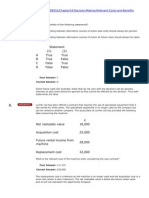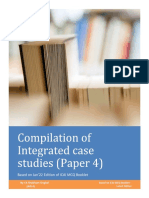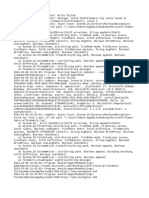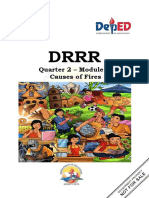Ias 16
Ias 16
Uploaded by
CandyCopyright:
Available Formats
Ias 16
Ias 16
Uploaded by
CandyOriginal Description:
Original Title
Copyright
Available Formats
Share this document
Did you find this document useful?
Is this content inappropriate?
Copyright:
Available Formats
Ias 16
Ias 16
Uploaded by
CandyCopyright:
Available Formats
IAS 16 Property, plant and equipment
An asset is a resource controlled by the entity as a result of past events and from which future
economic benefits are expected flow to the entity.
Property, plant and equipment are tangible assets that:
are held for use in the production or supply of goods or services, for rental to others, or for
administrative purposes; and
are expected to be used during more than one period.
-
Initial recognition:
PPE should initially be recognised in an entity's statement of financial position at cost.
Cost is the amount of cash and cash equivalents paid to acquire the asset at the time of its
acquisition or construction PLUS the fair value of any other consideration given.
Elements of Cost: Cost can include:
Purchase price less any trade discount (not prompt payment discount) or rebate
Import duties and non-refundable purchase taxes
Directly attributable costs of bringing the asset to working condition for its intended use.
Examples:
Where these costs are incurred over a
Costs of site preparation
period of time, the period for which the
Initial delivery and handling costs
costs can be included in the cost of PPE
Installation and assembly costs
ends when the asset is ready for use,
even if not brought into use.
Professional fees such as legal fees, architects fees
Initial costs of testing that asset is functioning correctly
(after deducting the net proceeds from selling any items produced)
The initial estimate of dismantling and removing the item and restoring the site where it is
located if the entity is obliged to do so (to the extent it is recognised as a provision per IAS 37).
Gains from the expected disposal of assets should not be taken into account in measuring a
provision.
In case of a land, if initial estimation of restoration cost is capitalised then this capitalised
restoration cost shall be depreciated.
Borrowing costs incurred in the construction of qualifying assets if in accordance with IAS 23
Borrowing costs.
Any abnormal costs incurred by the entity, for example those arising from design errors,
wastage or industrial disputes, should be expensed as they are incurred and do not form
part of the capitalised cost of the PPE asset.
Estimated economic life and residual value of asset should be reviewed at the end of
each reporting period. If either changes significantly, the change should be accounted for
over the useful economic life remaining.
The residual value of an asset is the estimated amount that an entity would currently
obtain from disposal of the asset, after deducting the estimated costs of disposal, if the
asset were already of the age and in the condition expected at the end of its useful life. [IAS
16: 6]
Subsequent expenditure only to be capitalised if enhances the life of the asset, or improves
quality or quantity of output, or reduces the cost. If not capitalised then recognise as
expense in I/S.
Examples of subsequent expenditure to be capitalised can include:
Modification of an item of plant to extend its useful life
Upgrade of machine parts to improve the quality of output
Adoption of a new production process, leading to large reductions in operating costs
Where an asset is made up of many distinct (i.e. significant) parts (examples: aircraft, ship),
these should be separately identified and depreciated.
Major inspections or overhauls should be recognised as part of (i.e. increase) carrying amount
of the item of PPE, assuming that this meets the recognition criteria.
An example is where an aircraft is required to undergo a major inspection after so many
flying hours. Without the inspection the aircraft would not be permitted to continue flying.
As a separate component of PPE, the capitalised overhaul cost shall be depreciated over
the period to next overhaul.
Measurement after initial recognition: After initially recognising an item of property, plant and
equipment in its statement of financial position at cost, an entity has two choices about how it
accounts for that item going forwards.
Cost model:
Carrying asset at cost less accumulated
depreciation and impairment losses
Revaluation model:
Carrying asset at revalued amount less
subsequent accumulated depreciation and
impairment losses
Revaluation model:
An entity can, if it chooses, revalue assets to their fair value (only if the fair value of the item
can be measured reliably)
For land and buildings this is normally determined based on their market values as determined
by an appraisal undertaken by professionally qualified valuers.
If this model is applied to one asset, it must also be applied to all other assets in the same
class.
Note that when the revaluation model is used PPE must still be depreciated. The revalued
amount is depreciated over the asset's remaining useful life.
For a revalued asset, IAS 16 allows (and encourage) a reserve transfer in the statement of
changes in equity (from revaluation reserve to retained earnings) of the 'excess'
depreciation because of an upward revaluation.
Methods of depreciation:
Straight line method
Reducing balance method
Machine hour method
Sum-of-the-digits method
Sum of the years of assets expected life = N X (N+1)/2 where N is the
assets expected life
Cost of a lorry was $15,000 and expected to last for five years. No scrap
value.
Sum of the years of assets expected life = N X (N+1)/2 = 5 X (5+1)/2 = 15
Depreciation in Year
1
2
3
4
$15,000
$15,000
$15,000
$15,000
X
X
X
X
5
4
3
2
/15
/15
/15
/15
= $5,000
=$4,000
= $3,000
= $2,000
Derecognition: Property, plant and equipment shall be derecognised (i.e. removed from the
statement of financial position) either:
On disposal; or
When no future economic benefits are expected from its use or disposal.
The gain or loss arising from de-recognition is included in profit or loss.
This gain or loss is calculated by comparing the sale proceeds to the asset's carrying amount.
The gain or loss is calculated in the same way, regardless of whether the asset is revalued or
not.
Any gain should not be classified as part of the entity's revenue.
If on disposal of a revalued asset there remains a balance on the revaluation surplus relating to the
asset, this balance should be transferred to retained earnings.
You might also like
- Manual Trans Overhaul Chevrolet S10Document11 pagesManual Trans Overhaul Chevrolet S10Maxi Sardi100% (1)
- Compliance Checklist DG CBTA Training Programme (Non-Operator Entities)Document14 pagesCompliance Checklist DG CBTA Training Programme (Non-Operator Entities)liliovidiu100% (2)
- BillingstatementCCDC NewDocument5 pagesBillingstatementCCDC NewMatias SegoviaNo ratings yet
- Tutorial 4 QuestionsDocument4 pagesTutorial 4 Questionsguan junyan0% (1)
- Module 8 & 9 Zairah AbilaDocument38 pagesModule 8 & 9 Zairah AbilaEfigenia Macadaan Fontillas80% (5)
- Aafr Ias 12 Icap Past Paper With SolutionDocument17 pagesAafr Ias 12 Icap Past Paper With SolutionAqib Sheikh100% (1)
- Sample Question Papers For Certificate Course On Ind AS: The Institute of Chartered Accountants of IndiaDocument36 pagesSample Question Papers For Certificate Course On Ind AS: The Institute of Chartered Accountants of IndiaChristen CastilloNo ratings yet
- Rel Costing RevDocument5 pagesRel Costing RevJenicareen Eulalio67% (3)
- IAS 1 Presentation of Financial StatementsDocument74 pagesIAS 1 Presentation of Financial StatementsCandyNo ratings yet
- FA Chapter 1 Financial Reporting and The Financial StatementsDocument115 pagesFA Chapter 1 Financial Reporting and The Financial StatementsAn NguyenNo ratings yet
- 1-Knowledge Assurance SM PDFDocument350 pages1-Knowledge Assurance SM PDFShahid MahmudNo ratings yet
- Accounting For PropertyDocument6 pagesAccounting For PropertyBijoy SalahuddinNo ratings yet
- Auditing BitsDocument48 pagesAuditing BitskalyanikamineniNo ratings yet
- Accounts GRP 1 BitsDocument40 pagesAccounts GRP 1 BitskalyanikamineniNo ratings yet
- T5-June 2013-TAXATIONDocument24 pagesT5-June 2013-TAXATIONMosesNo ratings yet
- Chapter 1 - Updated-1 PDFDocument29 pagesChapter 1 - Updated-1 PDFj000diNo ratings yet
- Paper - 5: Financial Accounting Bit QuestionsDocument40 pagesPaper - 5: Financial Accounting Bit QuestionsDalwinder Singh100% (1)
- T1 - KMLT 2015 - ThanhDocument35 pagesT1 - KMLT 2015 - ThanhCavipsotNo ratings yet
- Ultimate Solution Integrated Case Scenarios 1Document87 pagesUltimate Solution Integrated Case Scenarios 1NehaNo ratings yet
- 2.100 IMP MCQ of Stats by Pranav PopatDocument117 pages2.100 IMP MCQ of Stats by Pranav PopatHarsh JadavNo ratings yet
- Question Bank 2021Document168 pagesQuestion Bank 2021Yasir KhanNo ratings yet
- Fa Mcqs (Icap)Document133 pagesFa Mcqs (Icap)MUHAMMAD ASLAMNo ratings yet
- 2013 Paper F8 QandA Sample Download v1 PDFDocument161 pages2013 Paper F8 QandA Sample Download v1 PDFAnu Babloo100% (2)
- Intermediate Accounting I Intangible AssetsDocument7 pagesIntermediate Accounting I Intangible AssetsKyla Flaviano GallegoNo ratings yet
- F7 Mock Questions 201603Document20 pagesF7 Mock Questions 201603DG Mero Nepal GreatNo ratings yet
- 1.B.Com.Document49 pages1.B.Com.deepakNo ratings yet
- CA Inter Costing Scanner by Enkindled MindsDocument259 pagesCA Inter Costing Scanner by Enkindled MindsILLEGAL SUNNo ratings yet
- RadDocument40 pagesRadCacptCoachingNo ratings yet
- Caf 6 PT QB Icap Caf 6 Question Bank Caf 6 Principles of TaxationDocument167 pagesCaf 6 PT QB Icap Caf 6 Question Bank Caf 6 Principles of TaxationRabiya AsifNo ratings yet
- MA R. Kit As at 7-04-06Document360 pagesMA R. Kit As at 7-04-06mwiyomiraa77% (13)
- Example 1 - Over and Under Provision of Current TaxDocument14 pagesExample 1 - Over and Under Provision of Current TaxPui YanNo ratings yet
- ACCA F4 To P7 Short NotesDocument1 pageACCA F4 To P7 Short Noteshassan malikNo ratings yet
- Ias 40Document20 pagesIas 40Reever RiverNo ratings yet
- 06 JUNE AnswersDocument13 pages06 JUNE AnswerskhengmaiNo ratings yet
- Substantive Testing For PPEDocument11 pagesSubstantive Testing For PPEPaul Anthony AspuriaNo ratings yet
- Cma p1 Mock Exam 2 ADocument34 pagesCma p1 Mock Exam 2 ATalalTANo ratings yet
- Accounting Chapter 2 MCQ by Nobel Professional AcademyDocument16 pagesAccounting Chapter 2 MCQ by Nobel Professional AcademytafsirmhinNo ratings yet
- A) Discuss The Managing Director's Pricing Strategy in The Circumstances Described Above. (5 Marks)Document17 pagesA) Discuss The Managing Director's Pricing Strategy in The Circumstances Described Above. (5 Marks)Hannah KayyNo ratings yet
- Becker f6Document71 pagesBecker f6Safa RoxNo ratings yet
- f8 RQB 15 Sample PDFDocument98 pagesf8 RQB 15 Sample PDFChandni VariaNo ratings yet
- Chapter 2 Management Information MCQ of CLDocument4 pagesChapter 2 Management Information MCQ of CLirafayet1No ratings yet
- Aafr Ifrs 15 Icap Past Papers With SolutionDocument10 pagesAafr Ifrs 15 Icap Past Papers With SolutionAqib Sheikh0% (1)
- Bean (Basic) : Required: (ACCA SBR Kaplan Book) 19Document1 pageBean (Basic) : Required: (ACCA SBR Kaplan Book) 19.No ratings yet
- Cma Question - r1 - Legal Environment of BusinessDocument12 pagesCma Question - r1 - Legal Environment of BusinessMuhammad Ziaul Haque100% (1)
- CAF2 Workshop (Business Income and STX Questions)Document9 pagesCAF2 Workshop (Business Income and STX Questions)Abdul qadirNo ratings yet
- Cima C1Document52 pagesCima C1hopeaccaNo ratings yet
- ICAGH Management Accounting Question and SolutionDocument17 pagesICAGH Management Accounting Question and SolutionTimore Francis100% (1)
- Indian Accounting Standard 16: © The Institute of Chartered Accountants of IndiaDocument7 pagesIndian Accounting Standard 16: © The Institute of Chartered Accountants of IndiaRITZ BROWNNo ratings yet
- ACCA F5 December 2015 Lecture NotesDocument214 pagesACCA F5 December 2015 Lecture NotesopentuitionID100% (2)
- Advanced Financial Management PDFDocument6 pagesAdvanced Financial Management PDFSmag SmagNo ratings yet
- Part F - Additional QuestionsDocument9 pagesPart F - Additional QuestionsDesmond Grasie ZumankyereNo ratings yet
- Lecture # 12Document19 pagesLecture # 12bwcs1122No ratings yet
- Multiple Choice Questions Accounting PoliciesDocument4 pagesMultiple Choice Questions Accounting PoliciesUy Uy ChoiceNo ratings yet
- Chapter Five Part One: Business ValuationDocument57 pagesChapter Five Part One: Business ValuationMikias Degwale100% (1)
- Assurance (A Combination Between Manual & Suggested Answers Upto May-June '2019) PDFDocument110 pagesAssurance (A Combination Between Manual & Suggested Answers Upto May-June '2019) PDFS M Tanjilur RahmanNo ratings yet
- Accounting For Islamic BanksDocument31 pagesAccounting For Islamic BanksShaikhaAlnoaimiNo ratings yet
- Section D ACCA PM NotesDocument9 pagesSection D ACCA PM NotesCorrinaNo ratings yet
- 1.8audit and AssuranceDocument179 pages1.8audit and AssuranceAhmed TallanNo ratings yet
- Property, Plant and Equipment: By:-Yohannes Negatu (Acca, Dipifr)Document37 pagesProperty, Plant and Equipment: By:-Yohannes Negatu (Acca, Dipifr)Eshetie Mekonene AmareNo ratings yet
- Ias 16 PropertyDocument11 pagesIas 16 PropertyFolarin EmmanuelNo ratings yet
- Ppe (Ias 16)Document16 pagesPpe (Ias 16)Sumon PaulNo ratings yet
- 07 PPE Cost s16 FINALDocument31 pages07 PPE Cost s16 FINALVenniah MusundaNo ratings yet
- IAS-16 (Property, Plant & Equipment)Document20 pagesIAS-16 (Property, Plant & Equipment)Nazmul HaqueNo ratings yet
- Theory of Accounting - SUMMARY of PPEDocument15 pagesTheory of Accounting - SUMMARY of PPESteven Chou100% (2)
- DataBase MRODocument36 pagesDataBase MROfatah rahmanNo ratings yet
- SquirrelSetup Varad HingeDocument9 pagesSquirrelSetup Varad HingeArvind HingeNo ratings yet
- MOU Acorn - Bell 1Document2 pagesMOU Acorn - Bell 1Bell InstituteNo ratings yet
- PHD Thesis Wireless CommunicationDocument8 pagesPHD Thesis Wireless Communicationmizhesternewark100% (2)
- Malaysia: Lim Goh TongDocument28 pagesMalaysia: Lim Goh TongShanmugapriya SundramuthiNo ratings yet
- Course - Registration Guidelines IiscDocument5 pagesCourse - Registration Guidelines IiscSiddhant DoshiNo ratings yet
- Most Asked Active Directory Interview Questions (2023)Document11 pagesMost Asked Active Directory Interview Questions (2023)Pankaj ChaudharyNo ratings yet
- Draf Cadangan Pindaan TU 2018Document47 pagesDraf Cadangan Pindaan TU 2018Syam YasinNo ratings yet
- SLM 8-Week 4-Grade1112DRRR-2nd Quarter-Analyze The Different Causes of FiresDocument16 pagesSLM 8-Week 4-Grade1112DRRR-2nd Quarter-Analyze The Different Causes of FiresRomel BayabanNo ratings yet
- Is 2830 1992Document9 pagesIs 2830 1992Sunny SaparNo ratings yet
- MCTP 3-40BDocument194 pagesMCTP 3-40BYang Shijian100% (1)
- 2 - APUSH Period 9 Notes 2 - Reagan To H. W. Bush Reagan Foreign PolicyDocument25 pages2 - APUSH Period 9 Notes 2 - Reagan To H. W. Bush Reagan Foreign PolicyChrisNo ratings yet
- Demon Slayer Vol 1Document20 pagesDemon Slayer Vol 1veerag jamdarNo ratings yet
- Standard Algorithm NamesDocument24 pagesStandard Algorithm NamesAnonymous NSeuaSNo ratings yet
- Econocrat Article - Avighna Daruka 117 - KDocument2 pagesEconocrat Article - Avighna Daruka 117 - KAvighna DarukaNo ratings yet
- Evaluation of The Oxygen Concentrator Prototypes: Pressure Swing Adsorption Prototype and Electrochemical PrototypeDocument42 pagesEvaluation of The Oxygen Concentrator Prototypes: Pressure Swing Adsorption Prototype and Electrochemical PrototypeAla Ibrahim JalladNo ratings yet
- The Balance of Payments and The Exchange RateDocument10 pagesThe Balance of Payments and The Exchange RateOtis MelbournNo ratings yet
- Bkmeapolo Ud 17Document9 pagesBkmeapolo Ud 17Md Joinal AbedinNo ratings yet
- Small Service CertificateDocument5 pagesSmall Service CertificateSidvik InfotechNo ratings yet
- NSE Finmahotsav BrochureDocument16 pagesNSE Finmahotsav BrochureImmortal ProNo ratings yet
- Molded Part PredictionDocument5 pagesMolded Part Predictiongunawan refiadiNo ratings yet
- Assessing Goals of Urology Residency Program in TASH, A.A.U, Addis Ababa EthiopiaDocument47 pagesAssessing Goals of Urology Residency Program in TASH, A.A.U, Addis Ababa EthiopiaMekbeb ChereNo ratings yet
- Jina AI e Brief v4Document10 pagesJina AI e Brief v4priyanshu.jain4999No ratings yet
- USDINR Option StrategyDocument1 pageUSDINR Option Strategynarendra_pNo ratings yet
- (Ebooks PDF) Download Greenhouse Technology and Management 2nd Edition Nicolás Castilla Full ChaptersDocument84 pages(Ebooks PDF) Download Greenhouse Technology and Management 2nd Edition Nicolás Castilla Full Chaptersjayneyallmir100% (19)
- Photosynthesis Lab ReportDocument7 pagesPhotosynthesis Lab ReportCecilia LindbergNo ratings yet

























































































